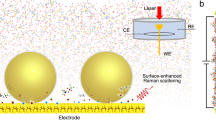Abstract
During the course of our investigation of the electron transfer properties of some redox species through highly hydrophobic long chain alkanethiol molecules on gold in aqueous and non-aqueous solvents, we obtained some intriguing results such as unusually low interfacial capacitance, very high values of impedance and film resistance, all of which pointed to the possible existence of a nanometer size interfacial gap between the hydrophobic monolayer and aqueous electrolyte. We explain this phenomenon by a model for the alkanethiol monolayer—aqueous electrolyte interface, in which the extremely hydrophobic alkanethiol film repels water molecules adjacent to it and in the process creates a shield between the monolayer film and water. This effectively increases the overall thickness of the dielectric layer that is manifested as an abnormally low value of interfacial capacitance. This behaviour is very much akin to the ‘drying transition’ proposed by Lum, Chandler and Weeks in their theory of length scale dependent hydrophobicity. For small hydrophobic units consisting of apolar solutes, the water molecules can reorganize around them without sacrificing their hydrogen bonds. Since for an extended hydrophobic unit, the existence of hydrogen bonded water structure close to it is geometrically unfavourable, there is a net depletion of water molecules in the vicinity leading to the possible creation of a hydrophobic interfacial gap.
Similar content being viewed by others
References
W Kauzmann,Adv. Prot. Chem. 14, 1 (1959)
G Hummer, J C Rasaiah and J P Noworyta,Nature 414, 188 (2001)
O Beckstein, P C Biggin and M S P Sansom,J. Phys. Chem. B105, 12902 (2001)
H O Finklea,Electrochemistry of organized monolayers of thiols and related molecules on electrodes edited by A J Bard and I Rubinstein (Marcel Dekker, New York, 1996)
A Ulman,An introduction to ultrathin organic films (Academic Press, San Diego, 1991) p. 286
R G Nuzzo and D L Allara,J. Am. Chem. Soc. 105, 4481 (1983)
C E D Chidsey and D N Loiacono,Langmuir 6, 682 (1990)
C A Widrig, C A Alves and M D Porter,J. Am. Chem. Soc. 113, 2 (1991)
A Ulman, J E Eilers and N Tillman,Langmuir 5, 1147 (1989)
H O Finklea, S Avery, M Lynch and R Furtsch,Langmuir 3, 409 (1987)
A M Becka and C J Miller,J. Phys. Chem. 96, 2657 (1992)
K L Prime and G M Whitesides,Science 252, 1164 (1991)
U K Sur and V Lakshminarayanan,J. Colloid Interface Sci. 254, 410 (2002)
J Diebel, H Lowe, P Samori and J P Rabe,Appl. Phys. A73, 273 (2001)
R Subramanian and V Lakshminarayanan,Electrochim. Acta 45, 501 (2000)
T M Nahir and E F Bowden,Electrochim. Acta 39, 2347 (1994)
C Frubose and K Doblhofer,J. Chem. Soc. Faraday Trans. 91, 1949 (1995)
D Yan, J A Saunders and G K Jennings,Langmuir 18, 10202 (2002)
V Lakshminarayanan,Curr. Sci. 74, 413 (1998)
L R Pratt and D Chandler,J. Chem. Phys. 67, 3683 (1977)
F H Stillinger,J. Solution Chem. 2, 141 (1973)
H K Christenson and P M Claesson,Science 239, 390 (1988)
W A Ducker, Z Xu and J N Israelachvili,Langmuir 10, 3279 (1994)
J L Parker, P M Claesson and P J Attard,J. Phys. Chem. 98, 8468 (1994)
R M Pashley, P M McGuiggan, B W Ninham and D F Evans,Science 229, 1088 (1985)
H K Christenson and P M Claesson,Adv. Colloid Interface Sci. 91, 391 (2001)
L F Scatena, M G Brown and G L Richmond,Science 292, 908 (2001)
X Zhang, Y Zhu and S Granick,Science 295, 663 (2002)
K Lum, D Chandler and J D Weeks,J. Phys. Chem. B103, 4570 (1999)
D Chandler,Nature 417, 491 (2002)
L Sun and R M Crooks,J. Electrochem. Soc. 138, L23 (1991)
W Plieth, W Kozlowski and T Twomey,Adsorption of molecules at metal electrodes edited by J Lipkowski and P N Ross (VCH, New York, 1992) ch. 5, p. 269
J Lipkowski and P N Ross (eds),Adsorption of molecules at metal electrodes (VCH, New York, 1992) pp. 91, 186
B B Damaskin, O A Petrii and V V Batrakov,Adsorption of organic compounds on electrodes (Plenum Press, New York, 1971)
B Kronberg,J. Colloid Interface Sci. 96, 55 (1983)
Author information
Authors and Affiliations
Rights and permissions
About this article
Cite this article
Lakshminarayanan, V., Sur, U.K. Hydrophobicity-induced drying transition in alkanethiol self-assembled monolayer—water interface. Pramana - J Phys 61, 361–371 (2003). https://doi.org/10.1007/BF02708316
Issue Date:
DOI: https://doi.org/10.1007/BF02708316
Keywords
- Hydrophobicity
- hydrophobic gap
- self-assembled monolayer
- length scale dependent hydrophobicity
- interfacial capacitance
- uncompensated solution resistance




